2000 FORD WINDSTAR traction control
[x] Cancel search: traction controlPage 81 of 280
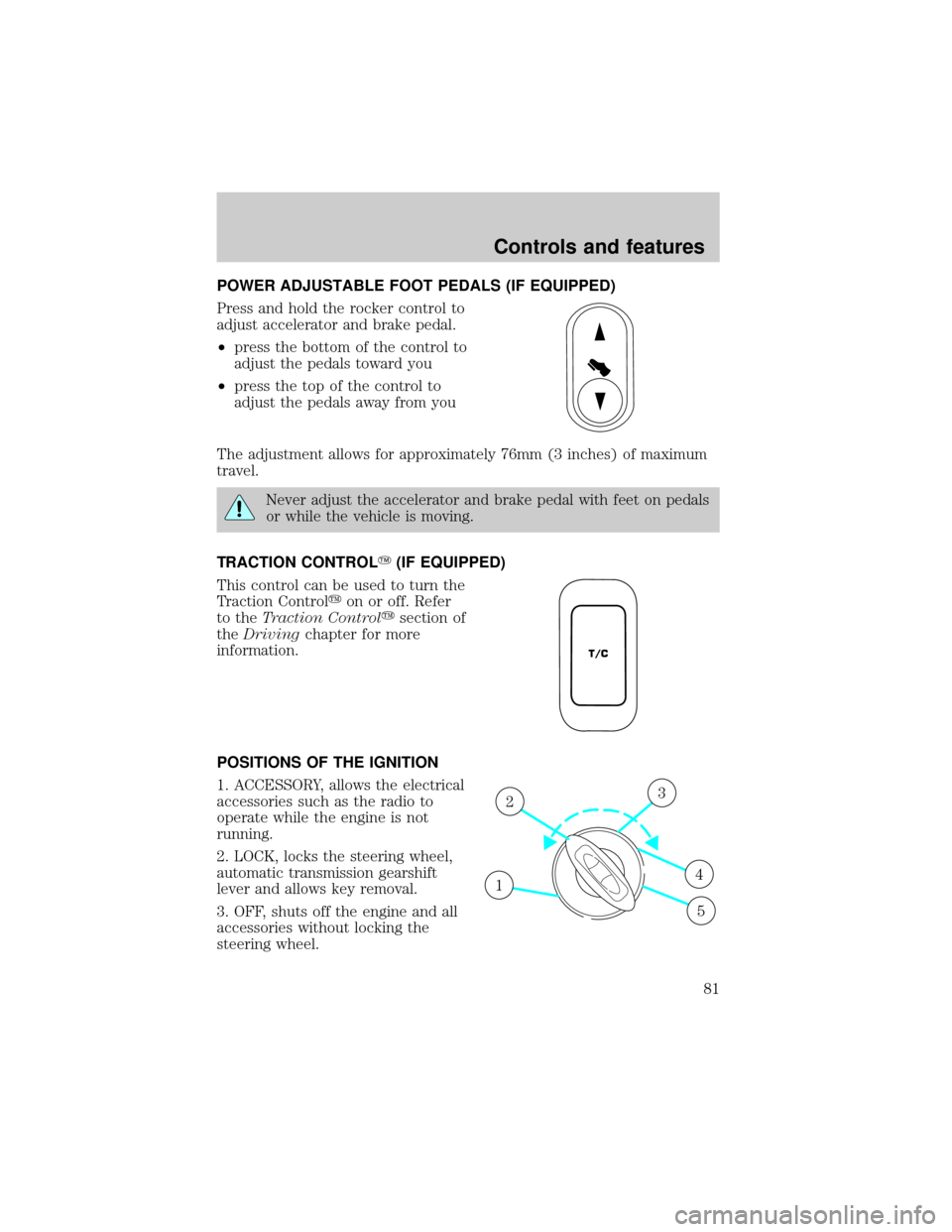
POWER ADJUSTABLE FOOT PEDALS (IF EQUIPPED)
Press and hold the rocker control to
adjust accelerator and brake pedal.
²press the bottom of the control to
adjust the pedals toward you
²press the top of the control to
adjust the pedals away from you
The adjustment allows for approximately 76mm (3 inches) of maximum
travel.
Never adjust the accelerator and brake pedal with feet on pedals
or while the vehicle is moving.
TRACTION CONTROLY(IF EQUIPPED)
This control can be used to turn the
Traction Controlyon or off. Refer
to theTraction Controlysection of
theDrivingchapter for more
information.
POSITIONS OF THE IGNITION
1. ACCESSORY, allows the electrical
accessories such as the radio to
operate while the engine is not
running.
2. LOCK, locks the steering wheel,
automatic transmission gearshift
lever and allows key removal.
3. OFF, shuts off the engine and all
accessories without locking the
steering wheel.
T/C
1
23
4
5
Controls and features
81
Page 167 of 280
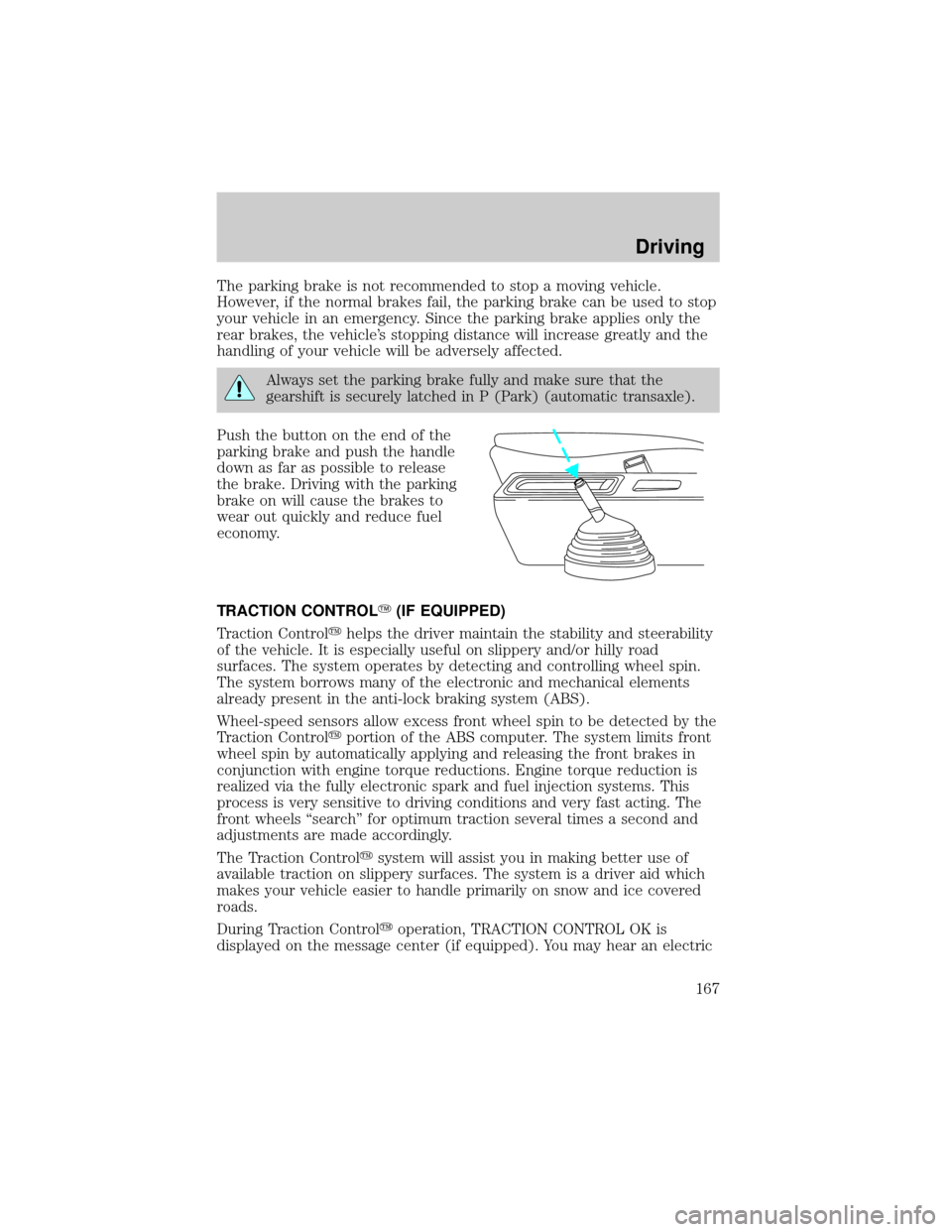
The parking brake is not recommended to stop a moving vehicle.
However, if the normal brakes fail, the parking brake can be used to stop
your vehicle in an emergency. Since the parking brake applies only the
rear brakes, the vehicle's stopping distance will increase greatly and the
handling of your vehicle will be adversely affected.
Always set the parking brake fully and make sure that the
gearshift is securely latched in P (Park) (automatic transaxle).
Push the button on the end of the
parking brake and push the handle
down as far as possible to release
the brake. Driving with the parking
brake on will cause the brakes to
wear out quickly and reduce fuel
economy.
TRACTION CONTROLY(IF EQUIPPED)
Traction Controlyhelps the driver maintain the stability and steerability
of the vehicle. It is especially useful on slippery and/or hilly road
surfaces. The system operates by detecting and controlling wheel spin.
The system borrows many of the electronic and mechanical elements
already present in the anti-lock braking system (ABS).
Wheel-speed sensors allow excess front wheel spin to be detected by the
Traction Controlyportion of the ABS computer. The system limits front
wheel spin by automatically applying and releasing the front brakes in
conjunction with engine torque reductions. Engine torque reduction is
realized via the fully electronic spark and fuel injection systems. This
process is very sensitive to driving conditions and very fast acting. The
front wheels ªsearchº for optimum traction several times a second and
adjustments are made accordingly.
The Traction Controlysystem will assist you in making better use of
available traction on slippery surfaces. The system is a driver aid which
makes your vehicle easier to handle primarily on snow and ice covered
roads.
During Traction Controlyoperation, TRACTION CONTROL OK is
displayed on the message center (if equipped). You may hear an electric
Driving
167
Page 168 of 280

motor type of sound coming from the engine compartment and the
engine will not ªrev-upº when you push further on the accelerator. This
is normal system behavior.
If you should become stuck in snow or on a very slippery road surface,
try switching the Traction Controlysystem off with the traction control
switch located on the left hand side of the radio. This may allow excess
wheel spin to ªdigº the vehicle out or enable a successful ªrockingº
maneuver.
If the Traction Controlysystem is cycled excessively, the brake portion
of the system will shut down to prevent the front brakes from
overheating. A limited Traction Controlyfunction using only engine
torque reduction will still control wheels from over-spinning. When the
front brakes have cooled down, the system will again function normally.
Anti-lock braking is not affected by this condition and will function
normally during the cool down period.
If a system fault is detected, CHECK TRACTION CONTROL is displayed
on the message center, the ªTC OFFº warning indicator lamp is on and
your vehicle should be serviced.
STEERING
Your vehicle is equipped with power steering. Power steering uses energy
from the engine to help steer the vehicle.
To prevent damage to the power steering pump:
²Never hold the steering wheel to the extreme right or the extreme left
for more than a few seconds when the engine is running.
²Do not operate the vehicle with a low power steering pump fluid level.
If the power steering system breaks down (or if the engine is turned
off), you can steer the vehicle manually, but it takes more effort.
If the steering wanders or pulls, the condition could be caused by any of
the following:
²underinflated tire(s) on any wheel(s)
²high crown in center of road
²high crosswinds
²wheels out of alignment
²loose or worn components in steering linkage
Driving
168
Page 196 of 280
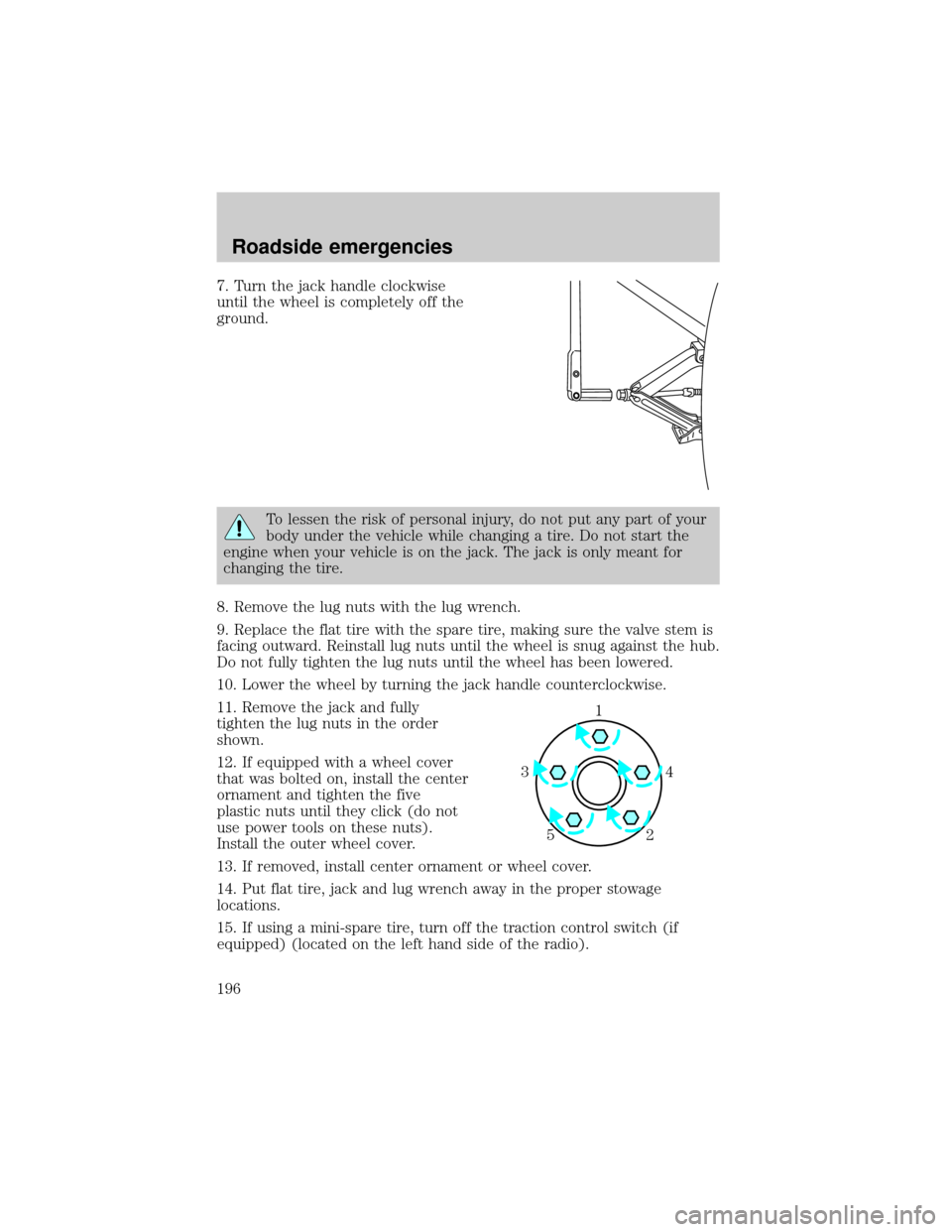
7. Turn the jack handle clockwise
until the wheel is completely off the
ground.
To lessen the risk of personal injury, do not put any part of your
body under the vehicle while changing a tire. Do not start the
engine when your vehicle is on the jack. The jack is only meant for
changing the tire.
8. Remove the lug nuts with the lug wrench.
9. Replace the flat tire with the spare tire, making sure the valve stem is
facing outward. Reinstall lug nuts until the wheel is snug against the hub.
Do not fully tighten the lug nuts until the wheel has been lowered.
10. Lower the wheel by turning the jack handle counterclockwise.
11. Remove the jack and fully
tighten the lug nuts in the order
shown.
12. If equipped with a wheel cover
that was bolted on, install the center
ornament and tighten the five
plastic nuts until they click (do not
use power tools on these nuts).
Install the outer wheel cover.
13. If removed, install center ornament or wheel cover.
14. Put flat tire, jack and lug wrench away in the proper stowage
locations.
15. If using a mini-spare tire, turn off the traction control switch (if
equipped) (located on the left hand side of the radio).
1
4 3
2 5
Roadside emergencies
196
Page 227 of 280
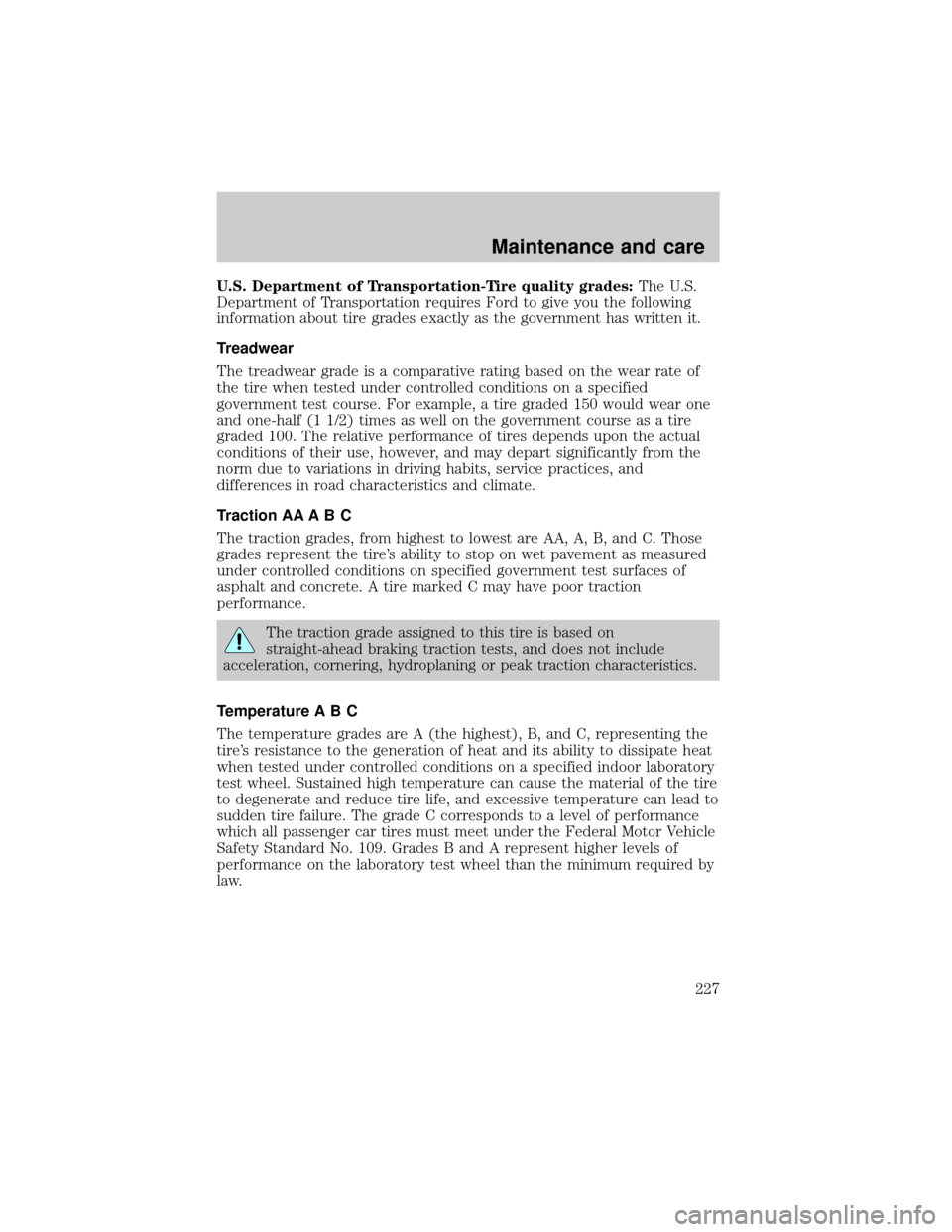
U.S. Department of Transportation-Tire quality grades:The U.S.
Department of Transportation requires Ford to give you the following
information about tire grades exactly as the government has written it.
Treadwear
The treadwear grade is a comparative rating based on the wear rate of
the tire when tested under controlled conditions on a specified
government test course. For example, a tire graded 150 would wear one
and one-half (1 1/2) times as well on the government course as a tire
graded 100. The relative performance of tires depends upon the actual
conditions of their use, however, and may depart significantly from the
norm due to variations in driving habits, service practices, and
differences in road characteristics and climate.
Traction AA A B C
The traction grades, from highest to lowest are AA, A, B, and C. Those
grades represent the tire's ability to stop on wet pavement as measured
under controlled conditions on specified government test surfaces of
asphalt and concrete. A tire marked C may have poor traction
performance.
The traction grade assigned to this tire is based on
straight-ahead braking traction tests, and does not include
acceleration, cornering, hydroplaning or peak traction characteristics.
Temperature A B C
The temperature grades are A (the highest), B, and C, representing the
tire's resistance to the generation of heat and its ability to dissipate heat
when tested under controlled conditions on a specified indoor laboratory
test wheel. Sustained high temperature can cause the material of the tire
to degenerate and reduce tire life, and excessive temperature can lead to
sudden tire failure. The grade C corresponds to a level of performance
which all passenger car tires must meet under the Federal Motor Vehicle
Safety Standard No. 109. Grades B and A represent higher levels of
performance on the laboratory test wheel than the minimum required by
law.
Maintenance and care
227
Page 230 of 280
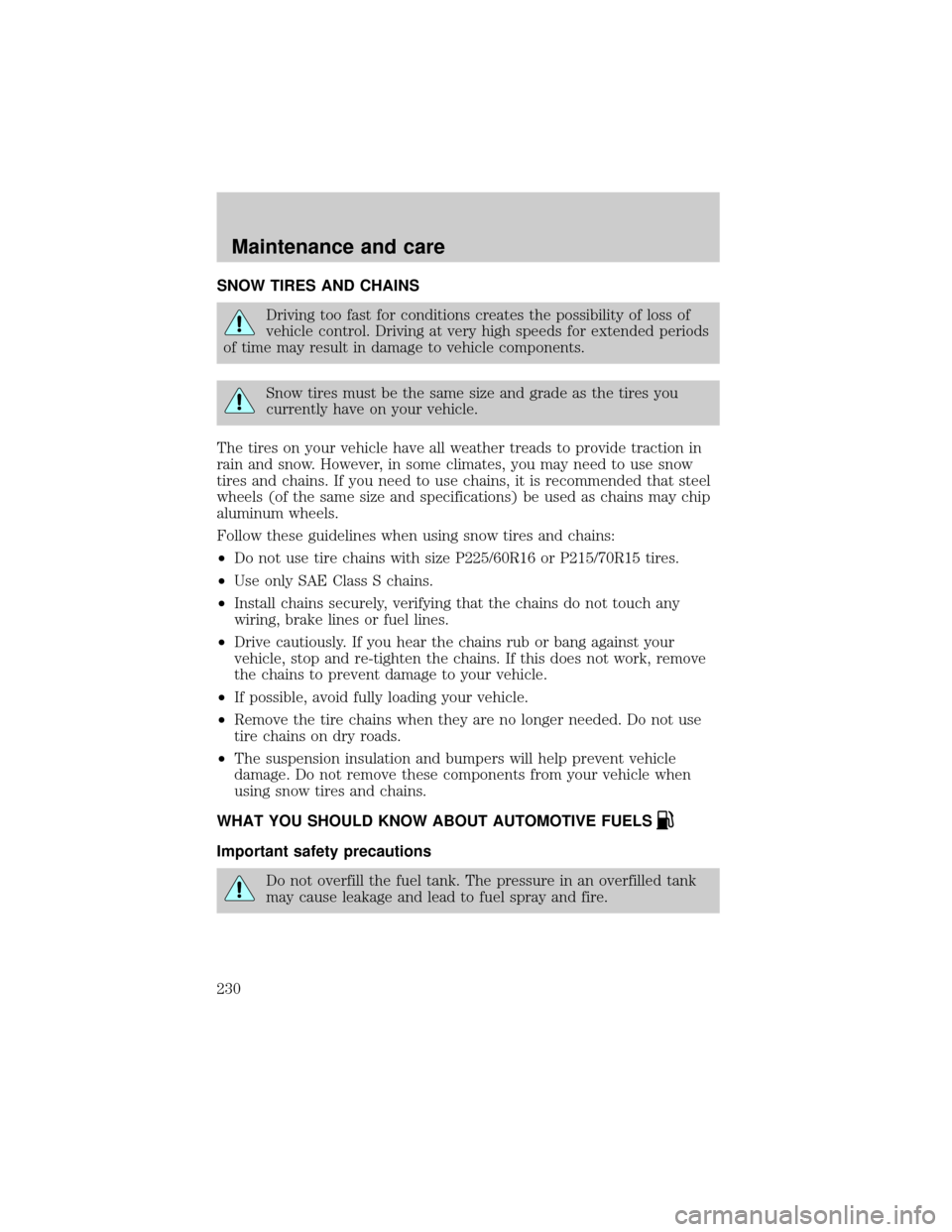
SNOW TIRES AND CHAINS
Driving too fast for conditions creates the possibility of loss of
vehicle control. Driving at very high speeds for extended periods
of time may result in damage to vehicle components.
Snow tires must be the same size and grade as the tires you
currently have on your vehicle.
The tires on your vehicle have all weather treads to provide traction in
rain and snow. However, in some climates, you may need to use snow
tires and chains. If you need to use chains, it is recommended that steel
wheels (of the same size and specifications) be used as chains may chip
aluminum wheels.
Follow these guidelines when using snow tires and chains:
²Do not use tire chains with size P225/60R16 or P215/70R15 tires.
²Use only SAE Class S chains.
²Install chains securely, verifying that the chains do not touch any
wiring, brake lines or fuel lines.
²Drive cautiously. If you hear the chains rub or bang against your
vehicle, stop and re-tighten the chains. If this does not work, remove
the chains to prevent damage to your vehicle.
²If possible, avoid fully loading your vehicle.
²Remove the tire chains when they are no longer needed. Do not use
tire chains on dry roads.
²The suspension insulation and bumpers will help prevent vehicle
damage. Do not remove these components from your vehicle when
using snow tires and chains.
WHAT YOU SHOULD KNOW ABOUT AUTOMOTIVE FUELS
Important safety precautions
Do not overfill the fuel tank. The pressure in an overfilled tank
may cause leakage and lead to fuel spray and fire.
Maintenance and care
230
Page 276 of 280

Lights, warning and indicator ......8
air bag ........................................10
anti-lock brakes (ABS) .....10,166
anti-theft .....................................9
brake ..........................................10
charging system ..........................8
check engine .............................11
door ajar ....................................12
high beam ............................10,12
low fuel ........................................8
low washer fluid .......................13
oil pressure ...............................10
overdrive off ..............................11
safety belt ...................................9
traction control active ................8
traction control off .....................9
turn signal indicator ...................9
Load limits .................................173
GAWR ......................................173
GVWR ......................................173
trailer towing ..........................173
Locks
autolock ...................................113
childproof ..................................92
Lubricant specifications ....256,257
Lumbar support, seats .............121
Message center ...........................16
english/metric button ...............17
system check button ................17
warning messages .....................18
Mirrors .........................................93
automatic dimming
rearview mirror .........................92
cleaning ...................................249
fold away ...................................91
heated ........................................91
side view mirrors (power) .......90
Motorcraft parts .................235,254
Octane rating ............................234
Odometer .....................................15
Oil (see Engine oil) ..................206
Overdrive ..............................87,169Panic alarm feature, remote
entry system ..............................109
Parking brake ............................166
Parts (see Motorcraft parts) ....254
Pedals (see Power
adjustable foot pedals) ...............81
Power adjustable foot pedals .....81
Power distribution box
(see Fuses) ...............................187
Power door locks .................91,113
Power steering ..........................168
fluid, checking and adding ....216
fluid, refill capacity ................255
fluid, specifications ..........256,257
Radio ............................................38
Relays ........................................182
Remote entry system ........105,109
illuminated entry ........27,110,113
locking/
unlocking doors ........106,107,108
panic alarm .............................109
replacement/additional
transmitters .............................112
replacing the batteries ...........110
Reverse sensing system .............78
Roof rack ...................................179
Safety belts (see Safety
restraints) ........13,130,131,133,135
Safety defects, reporting ..........272
Safety restraints ...130,131,133,135
belt minder .............................136
cleaning
the safety belts ................139,252
extension assembly ................135
for adults ..........................131,133
for children .............................148
lap belt ....................................134
warning light
and chime .................9,13,135,136
Safety seats for children ..........149
Seat belts
(see Safety restraints) .............130
Index
276
Page 277 of 280

Seats ..........................................119
child safety seats ....................149
cleaning ............................252,253
SecuriLock passive anti-theft
system ..........................114,115,116
Servicing your vehicle ..............203
Spark plugs,
specifications ......................254,257
Specification chart,
lubricants ............................256,257
Speed control ..............................82
Speedometer ...............................15
Starting your vehicle .........161,163
jump starting ..........................197
Steering wheel
tilting .........................................88
Tachometer .................................14
Tilt steering wheel ......................88
Tires ......................191,226,227,228
changing ....................191,192,194
checking the pressure ............228
replacing ..................................229
rotating ....................................228
snow tires and chains ............230
tire grades ...............................227
treadwear ................................227
Towing ................................175,228
trailer towing ..........................175
wrecker ....................................202
Traction control ...................81,167
active light ..................................8off light ........................................9
Transaxle
automatic operation ...............169
fluid, refill capacities ..............255
lubricant specifications ..........257
Transmission
fluid, checking and adding
(automatic) .............................218
lubricant specifications ..........256
Trip odometer .............................16
Turn signal ..........................9,13,85
Vehicle dimensions ...................257
Vehicle Identification
Number (VIN) ...........................259
Vehicle loading ..........................173
Ventilating your vehicle ...........164
Warning chimes ...........................13
Warning lights (see Lights) .........8
Washer fluid ..............................211
Water, Driving through .............173
Windows
power .........................................89
rear wiper/washer .....................86
Windshield washer
fluid and wipers
checking and adding fluid .....211
checking and cleaning .....225,226
liftgate reservoir .....................211
operation ...................................86
replacing wiper blades ...........226
Wrecker towing .........................202
Index
277